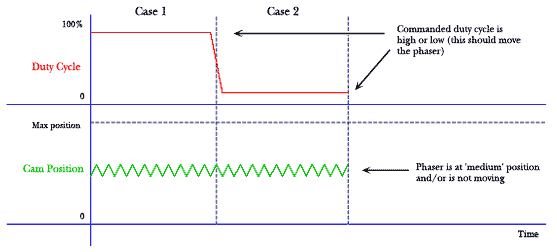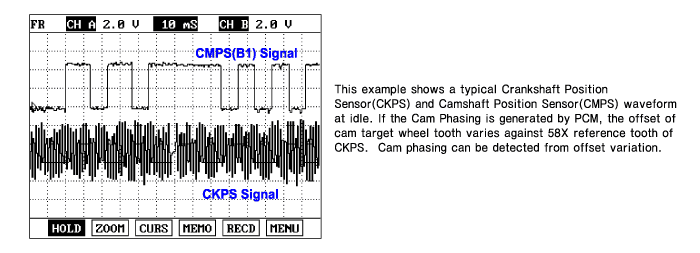

Different from the existing fixed cam phase angle type, CVVT(Continuously Variable Valve Timing) is the device which varies cam phase angle continuously to be optimum. And with engine oil pressure, it operates. CVVT consists of OCV(Oil Control Valve) and cam phaser. OCV, mounted on cylinder head, controlls the amount and direction of oil delivered to cam phaser by oil valve which is connected to a solenoid. Cam phaser, rotating cam phaser rotor with pressure and amount of oil produced by OCV, rotates cam shaft forcefully for or against the rotating direction and finally, cam shaft phase changes. With the appliance of CVVT, engine power,fuel efficiency and the quality of exhause gas are improved.
Figure1. illustrates the method for detecting unresolved phasing steady-state error.
The figure shows two cases, case 1 to the left of the dashed line, and case 2 to the right of the dashed line. In case 1,the duty cycle command is considered high, or above a calibration threshold memorized in PCM. This should cause the cam phaser to move toward the maximum position, but the position remains at a medium level. The range of positions considered ‘medium’ is defined by calibrations.
In case 2, the duty cycle command is considered low, or below a calibration threshold memorized in PCM. This should cause the cam phaser to move toward the minimum position, but the position remains at a medium level.
Each of these cases is a phaser position error failure. Each case is also considered to be due to a phaser seizure. When either case is detected, a timing counter begins to increment. If the counter exceeds a calibration threshold memorized in PCM, the failure criteria is TRUE.
Another similar diagnostic test is performed to check steady-state error. In this test, no consideration is given to the duty cycle command versus phaser position. This test is only a check of the phasing position error. In the test, if the phaser error is greater than a calibration threshold memorized in PCM,a timing counter increments. If the counter exceeds the calibration threshold memorized in PCM,the failure criteria is TRUE.

PCM monitors CAM phaser error while both cam offset is available and cam velocity is below 15CAD/s .If the CAM phaser does not move although PCM commands OCV duty cycle, PCM determines that a fault exists and a DTC is stored.
Item | Detecting Condition | Possible cause |
DTC Strategy | ● Determines if the phaser is stuck or has steady-state error | ● Engine Oil ● OCV ● CVVT stuck ● PCM |
Enable Conditions | ● Offsets available ● Cam velocity below threshold< 15 CAD/s | |
Threshold value | Case 1 | ● 5 CAD < Cam position< 50 CAD ● Duty Cycle >90% ● Duty Cycle< 10% ● Timing Counter >80 |
Case 2 | ● Cam Position error >15 CAD ● Timing Counter >80 | |
Diagnosis Time | ● Continuous (More than 0.75sec. Test failure for every 90sec tests) | |
MIL On Condition | ● 2 Driving Cycles |
